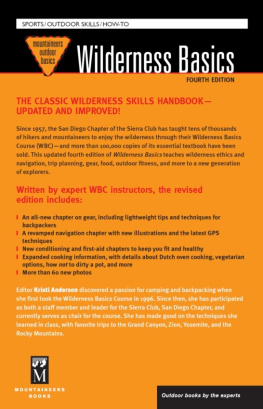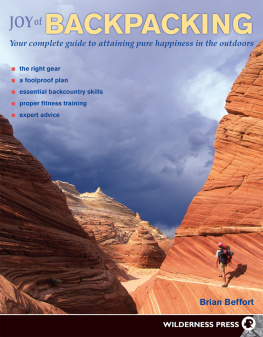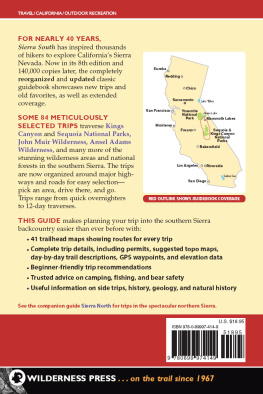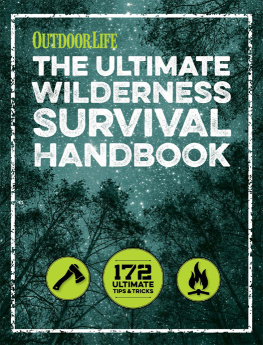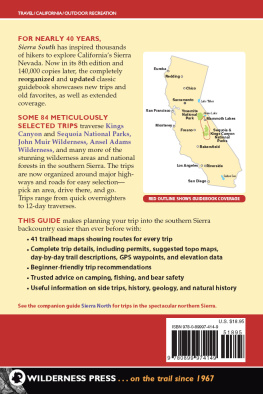
 | Mountaineers Books is the nonprofit publishing division of The Mountaineers, an organization founded in 1906 and dedicated to the exploration, preservation, and enjoyment of outdoor and wilderness areas.
1001 SW Klickitat Way, Suite 201 Seattle, WA 98134
800.553.4453 www.mountaineersbooks.org |
Copyright 2013 by the San Diego Chapter of the Sierra Club
All rights reserved. No part of this book may be reproduced or utilized in any form, or by any electronic, mechanical, or other means, without the prior written permission of the publisher.
Printed in the United States of America
Distributed in the United Kingdom by Cordee, www.cordee.co.uk
Second edition, 1993. Third edition, 2004. Fourth edition, 2013.
Copy editor: Kris Fulsaas
Design: Mountaineers Books
Layout: Shelly Garrison
Photos: See individual photos for credits.
Illustrations on pp. by Ben Pease, Robert Frost, and Bob Cram.
Cover photograph: Backpacker eating breakfast and enjoying an amazing sunrise in the high eastern Sierra near Bishop, California (Photo by Dan Girard)
Library of Congress Cataloging-in-Publication Data
Wilderness basics: get the most from your hiking, backpacking, and camping adventures / by the San Diego Chapter of the Sierra Club; edited by Kristi
Anderson. Fourth edition. pages cm
ISBN 978-1-59485-821-5 (pbk) ISBN 978-1-59485-822-2 (ebook)
1.Outdoor lifeWest (U.S.) 2. Wilderness survivalWest (U.S.)
I. Anderson, Kristi. II. Sierra Club. San Diego Chapter.
GV191.42.W47W55 2013
796.50978dc23
2013020452
ISBN (paperback): 978-1-59485-821-5
ISBN (ebook): 978-1-59485-822-2

Aubrey Wendling

Sandy Sanders

Jerry Schad
This book is dedicated to Aubrey Wendling, whose tireless efforts resulted in the creation of the Basic Mountaineering Course in 1957, which has evolved over the last fifty-six years into the current Wilderness Basics Course; to Sandy Sanders, who devoted so much of his life to the WBC as a staff member and outings leader; and to Jerry Schad, who explored and documented all the trails and wonders of the San Diego area. These three gentlemen represent the ideal of the Sierra Club and the Wilderness Basics Course to explore, enjoy, and protect the wild places of the earth. We are grateful to each of them.
Preface
John Muir, the driving force behind the creation of the national parks in 1872, went on to found the Sierra Club in San Francisco in 1892. In the late 1940s and early 1950s, the popularity of camping and hiking in the great California state parks and national parks increased dramatically. This was due, in part, to the rediscovery of the writings of John Muir, the thousands of young men who during the Great Depression had participated in the Civilian Conservation Corps (which helped create the facilities and trails in the national parks), and the vast number of veterans home from World War II. These people and their families wanted to discover and explore the wilderness areas of California and to find a sense of peace and adventure. Unfortunately, many people were venturing into the mountains and deserts without the knowledge to find their way, avoid dangerous animals, and survive the sudden changes in weather. After all, John Muir wrote that he would spend weeks in the Sierras with just a loaf of bread and a wool coat! How hard could it be?
Today, people still want to escape the pressures of work and society and are turning to the great outdoors in increasing numbers. Studies have shown that hiking through the wilderness is more therapeutic than prescription pharmaceuticals (for many people), and wilderness areas are some of the few places left where you can get away from it all. With a pack on your back, the trail becomes your sanctuary and time slips away while you explore in quiet solitude.
This book, Wilderness Basics and the classic Mountaineering Basics have been revised several times over the years to reflect innovations in equipment, knowledge of nature and wildlife, and emergency procedures. One of the trends today is the popularity of lighter and more versatile gear that allows the hiker to go farther, in greater safety and comfort. This light gear is very practical, but only if the hiker is skilled and experienced. Similarly, the low cost and accuracy of Global Positioning System (GPS) units makes these devices almost irresistible, but if they fail, hikers can be left in a situation beyond their abilities, without the equipment or skill to return home.
The information contained in this book can raise that skill level considerably, but the hiker also needs practical hands-on experience. This is one of the reasons that training opportunities such as the Wilderness Basics Course have become so popular. In the Wilderness Basics Course, students are able to learn in a relaxed classroom environment and also participate with seasoned hikers in weekend outings structured to increase their hands-on knowledge in the field.
This fourth edition features a fully updated chapter on gear, including lightweight gear tips and techniques to keep backpackers happy. The navigation chapter is thoroughly revamped to discuss the adjusted declination compass, with clearer diagrams to illustrate navigation concepts. With more than sixty new photos, current updates, and completely rewritten conditioning and first-aid chapters, this edition is one that we are confident the reader will want to keep around.
Many volunteers contributed endless hours to this new edition, but if it werent for the dedication and persistence of editor Kristi Anderson, this book would never have gone to press. We at the Wilderness Basics Course would also like to thank Diane Purkey Wilson and Skip Forsht, who spent long hours reviewing the content and helping to keep this edition on track.
As Baba Dioum, a Kenyan environmentalist, once said, In the end we will preserve only what we love, we will love only what we understand, and we will understand only what we are taught.
I hope you enjoy this book and use its information to explore, enjoy, and protect the wild places of the earth.
David Rousseau
Chair, 201112 Wilderness Basics Course
A NOTE ABOUT SAFETY
Safety is an important concern in all outdoor activities. No book can alert you to every hazard or anticipate the limitations of every reader. The descriptions of techniques and procedures in this book are intended to provide general information. This is not a complete text on wilderness travel technique. Nothing substitutes for formal instruction, routine practice, and plenty of experience. When you follow any of the procedures described here, you assume responsibility for your own safety. Use this book as a general guide to further information. Under normal conditions, excursions into the backcountry require attention to traffic, road and trail conditions, weather, terrain, the capabilities of your party, and other factors. Keeping informed on current conditions and exercising common sense are the keys to a safe, enjoyable outing.

